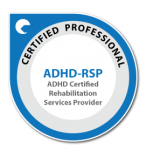

As parents, it is natural to be concerned about your child’s emotional well-being. Emotional highs and lows are frequently part of the ADHD profile, and parents can often feel helpless as they stand by and watch their child struggle with them. It is instinctual to want to smooth the way and prevent our children from feeling sad, angry, worried, and more, but in reality, we do kids no favors by protecting them from unpleasant emotions. Part of the job of parents is to help children navigate through difficult emotions by providing context and coping tools to challenging situations. (I would like to avoid the word “negative” when talking about emotions, because I do believe that life is 50/50 with the types of emotions we have. We are meant to experience them all, even the not-so-fun ones. More on this later!)
If you haven’t really thought about it in this way before, I urge you to read on.
The human experience is about feeling a range of emotions. We would not know what true happiness felt like if we’ve never experienced sadness or disappointment. We wouldn’t know contentment if we’ve never felt anger or worry. If everyone had the same thoughts and feelings about all of the same things, there would be no individuality, no intellectual growth, no trailblazing or discovery of new and diverse ideas.
So, back to what to do about that beautiful range of feelings and emotions. I hear parents say that they want their children to be able to control their big emotions. I agree – this is important. However, the goal of “emotional control” is not necessarily to feel better, but to learn to process and respond to emotions in ways that are not harmful to self or others.
Ideally, we will recognize that our children are having difficulty handling big emotions before they occur, and work on proactive strategies for solutions with them. However, sometimes (frequently) life throws in unexpected curveballs, and once the emotions are triggered, there is no stopping them. In Part 1 of this blog, I will talk about what to do with the “in the moment” emotions. Part 2 will cover handling situations that are likely to cause big emotions proactively.
These are the Three F’s of your body’s natural reaction to danger. Your “thinking brain” – the frontal lobe – takes a back burner when it senses danger. Instead, it is a part of your brain called the amygdala that responds quickly, sending information to the hypothalamus, and the autonomic nervous system responds with physiological and behavioral reactions.
If you are crossing the street on foot and a car is speeding toward you, the amygdala takes over. Your frontal lobe does not have time to consider the range of logical possibilities. Your brain will instinctively make your legs run fast – the flight response. There may be other situations where you freeze, or have the instinct to fight.
We cannot control those instances, nor should we. We need our more primitive brain to activate, in the name of survival.
Here’s the thing, though. Your brain is not necessarily discerning the “danger” of being chased by an animal or crossing a busy street with that of a parent screaming about homework not done, or being bullied on the playground, or any demand being made in the moment that a child cannot reliably meet. Sometimes, one of those “F’s” kick in , not in the name of survival, but in response to one of those other situations.
The following is a guide for handling in-the-moment big emotions, and they can be applied to children of any age.
I’ve written about empathy many times before – most recently in this post about Parenting ADHD With Empathy. I have come to understand that empathy is the key to improvement in relationships – all of them! As humans, we want others to feel like we are being heard and understood. When we enter the parent role, we often fear big emotions in our children, simply because it makes us feel helpless. If we can reframe those big emotions as an invitation to be empathetic, that could change your entire relationship.
One way to have empathy for what your child is feeling is to validate their emotions as real and important. You do not have to jump into the water with them and feel their anger, sadness, despair, worry or whatever it is. Validating simply means acknowledging that they are having that experience and it is true for them. If you find yourself brushing it off as unimportant, overblown, or silly, or you try to rush them out of the emotion (“chin up now! You’ve been crying for 20 minutes, that’s long enough!”), not only will your child feel unheard by the most important people in his/her life, but every other step will fail miserably.
NOTE: If your child is becoming destructive or causing harm to others, showing massive empathy will go a long way. The first step in this case is to keep everyone safe. You can diffuse and de-escalate while being empathetic by using phrases of validation. Agree that what they are going through or telling you is just as awful as they say it is. Let your child know that they can feel their feelings for as long as they need to. Do not try to rush them out of the feeling. Guide them to a safe area if people or possessions are in danger and move to step two.
A child or teen who is deep in a strong emotion that is having a negative impact on their actions does not have the ability yet to self-regulate. They cannot draw upon their logical brain and think of strategies to move past the moment. This is where co-regulation comes in. Your presence, your physical touch if they will allow it (a hug, a back rub) and your words of empathy will help them process the big emotions while staying safe. Sitting with a child and just breathing deeply with them can really help. Very young children may want to be held or wrapped up in a blanket, while teens may accept a hug or not You may need to step in and out of the room providing what is needed at the moment with kids who do not wish to be touched or bothered much, and take your cues from your child. These interactions, even brief ones, help the brain release positive neurotransmitters that tell them that they are safe and loved.
Your ability to be patient, control your own emotions, and hold space and time for your child is key before you can do any lecturing or lessons.
Once your child is beginning to calm down and regulate their big emotions a little better, you can model some basic deep breathing, and ask them to join you. If they still feel the emotion but can talk about it, ask them to describe it in as much detail as possible.
Then breathe into that area and imagine it getting smaller and smaller until it disappears. Depending on the age of your child, they may really take to this idea, or they may look at you like you are crazy. Either way, ask them to humor you and persist with this exercise, just to try it. You can model deep breathing as you did in the co-regulation step. You can also ask them to give it a name, to “humanize” it and make it less scary. Then when that emotion appears, they say “hi!” to it and “I know how to handle you!” instead of fearing it.
This technique is called processing the emotion, and it is a powerful one to use with big emotions. We, even as adults, tend to want to avoid and push away those feelings, and we never quite get past some. By doing the exact opposite, you are leaning in, allowing it to be there, acknowledging and going through it.
You can equate this to stretching a muscle. Let’s use the example of hamstrings, which are tight in most people. You would not sit down, extend your legs and try to touch your toes immediately. You would ease into it, breathing and relaxing while you feel the pull behind your thigh. You would go a little further and a little further, feeling the stretch as your tight muscle releases. This is how you process emotions. Breathe and feel the release.
We all say and do things in the heat of the moment that we regret. I ask parents and kids to go back and create a “re-do” on some of those interactions that have had a negative impact on them.
Parents are instrumental in the repair process by modeling what to do when they have big emotions that had undesired consequences. It is absolutely appropriate to apologize when necessary, and to let your child know where your reactions went wrong. This is the only way that they can learn from you and not repeat what they did, or what you did, in the future. Along the same vein, if your child said or did anything in the heat of the moment, allow them time and space to reflect on that, and what could be done differently next time.
As I stated earlier, proactively preventing meltdowns, destruction, swearing, and more is preferable than having to do it in the moment. In Part 2, we will learn proactive ways of handling big emotions in kids of all ages.
I work with kids and teens ages 5 – 18 and their families on these concepts every day. If you feel that you and your family can benefit from my services, fill out my ADHD questionnaire to see if ADHD coaching is a good fit!




Copyright 2024 © Kids Empowered 4 Life. All rights Reserved.
All information on the Website is presented as informational only and is not a replacement for therapy assessment, diagnosis, intervention, or medical advice. The information provided on the Website is provided “as is” without any representations or warranties, express or implied. Kids Empowered 4 Life assumes no responsibility for errors or omissions that may appear in the Website.